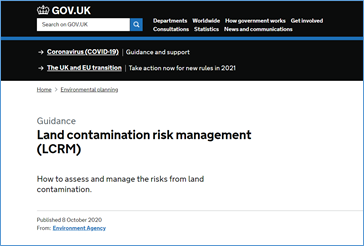
By Phil Fitzgerald, Environment Agency, Advisor: Land contamination management, Water, Land and Biodiversity
On the 8th October 2020 the Environment Agency (EA) republished Land Contamination Risk Management (LCRM). This replaces the Model procedures for the management of land contamination (CLR11), which has been withdrawn.
You can access the updated document from the GOV.UK website.
If you use this guidance outside of England, check with the relevant regulator about its suitability. Local authorities and other regulators may also provide additional guidance.
The EA first published LCRM in June 2019. This was reformed content based on the framework and principles established by CLR11. It represented a major and much needed update.
The EA asked for informal feedback and they had a huge response with about 350 comments from individuals and organisations.
A lot of feedback was provided on the usability of the GOV.UK publishing format – a GOV.UK manual. To address this the EA opted to use a different format. LCRM is now presented as 4 HTML guides that sit on a unique publication page. The HTML guides are:
- Before you start the risk management process.
- Risk assessment.
- Options appraisal.
- Remediation and verification.
Helpful checklists for reporting requirements are included at the end of each stage. The site investigation section, which now aligns more to the relevant British Standards, forms an integral part of the risk assessment stage.
The EA considered putting the whole document together as one single HTML but felt for online guidance it was better to break it down into relevant, useable sections.
Everyone needs to read before you start, then use a tiered approach to risk assessment (always starting with a preliminary risk assessment), then follow stages 2 and 3 in order.
You can print the 4 HTML guides, search for particular terms more easily and save them as PDFs if required.
The latest version will always be on GOV.UK.
For any future changes updates will be visible on the LCRM webpage. For any major updates the EA will also communicate via CL:AIRE e-alerts and through other routes such as twitter – @GeoscienceEA.
Feedback and changes
The majority of the comments were constructive and positive and the EA welcomed the feedback. The EA looked at:
- the technical content
- practical matters such as usability, printing, navigation and search
- the layout and structure including a lack of clarity over stages and tiers
- suggestions for new and improved content on for example, unexploded ordnance, communicating the risk, piling, geotechnical and treatability studies
- more alignment to British Standards for the site investigation section
They have also provided clarity and improved text on:
- who is a competent person
- the use of MCERTS and Rapid Measurement Techniques (RMTs)
- the use of Soil Guideline Values (SGVs) and Category 4 Screening Levels (C4SLs)
- ground gases and vapours
The term ‘contaminant linkage’ rather than ‘pollutant linkage’ is now used. Following the risk assessment stage, they become ‘relevant contaminant linkages.’
There is reference to the voluntary National Quality Mark Scheme (NQMS), which the EA support.
There is a link to the AGS guidance on unexploded ordnance. LCRM will continue to use and reference the CL:AIRE Water and Land Library.
There is now more emphasis on adopting a sustainable approach using for example, the SURF-UK Framework and BS ISO 18504: Soil quality – sustainable remediation.
The EA had feedback on the lack of flow charts. They felt that LCRM does not need all of the flow charts that were in CLR11. It now follows a logical and clear structure. However, they have not ruled this out and are still considering options.
There was a lot of feedback on the remediation option applicability matrix. This will be updated and re-published before the end of the year. The EA has concentrated on getting the main guidance document republished first as this was delayed due to the COVID-19 situation.
Accessible web content
The EA have to meet laws on producing accessible web content. It must be:
- accessible to people with disabilities such as visual, motor, cognitive and hearing impairments (in the UK 1 in 5 people have a disability)
- useable with assistive technology such as screen readers
- concise, clear and understandable to all
- available online to use on all devices (laptop, mobile phone, tablet) – about 50% of people viewing EA content now do so via a mobile phone
Withdrawal of CLR11
CLR11 has now been formally withdrawn.
The EA is aware that CLR11 is extensively referenced. There is no immediate action to replace all of these references. If people search GOV.UK for CLR11 they will be redirected to LCRM. For sites that the EA regulate, reference must now be made to LCRM not CLR11.
The archived version of CLR11 may still appear in other online searches. Please ignore this or be aware, that you can only use it for historical reference.
Popularity of LCRM
GOV.UK weekly user statistics show that since LCRM was published on the 8th Oct 2020 there has been a huge interest from the land contamination community with significant downloads.
Future updates
The EA will only be able to update LCRM periodically but if you want to provide any feedback you can continue to do so by emailing Phil Fitzgerald at groundwater.enquiries@environment-agency.gov.uk.
The EA wishes to thank everyone that took the time to respond. They would also like to thank Rebecca Fowler who is an EA digital editor for her excellent support in helping to produce LCRM.
The EA have stated that: “This is not just our guidance, we want industry to embrace it, help us to improve it and keep it up to date. It had a big act to follow.”